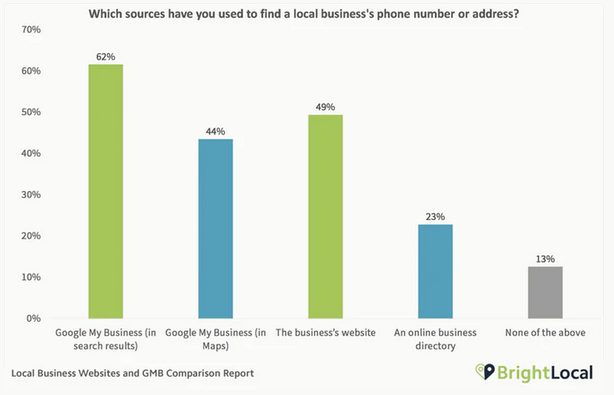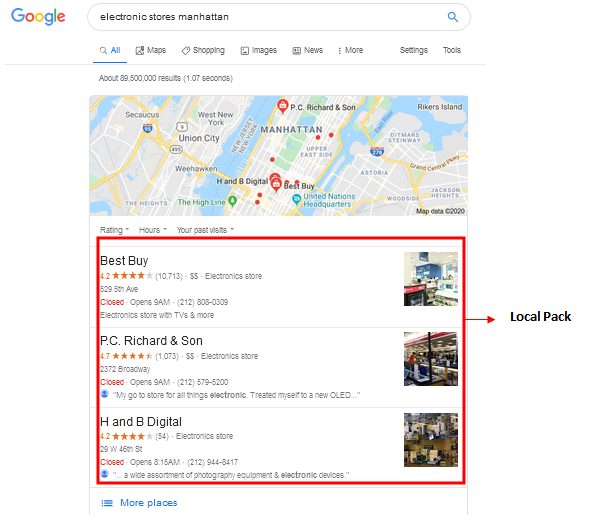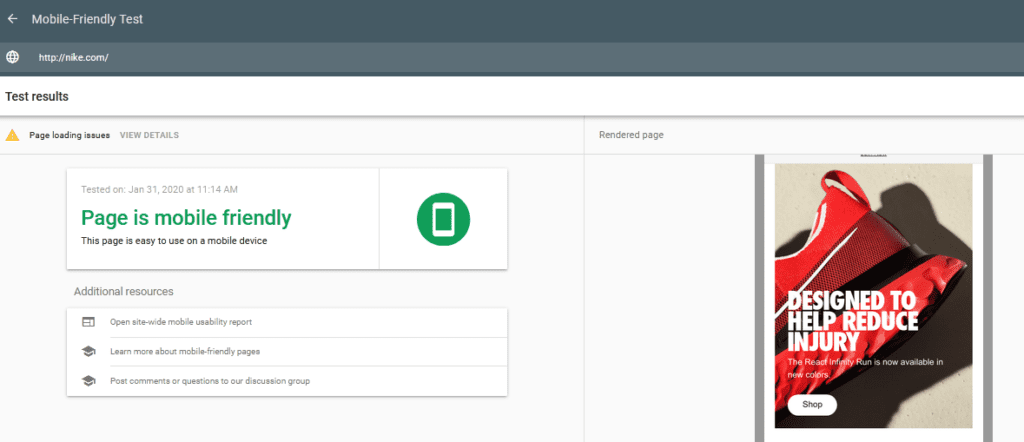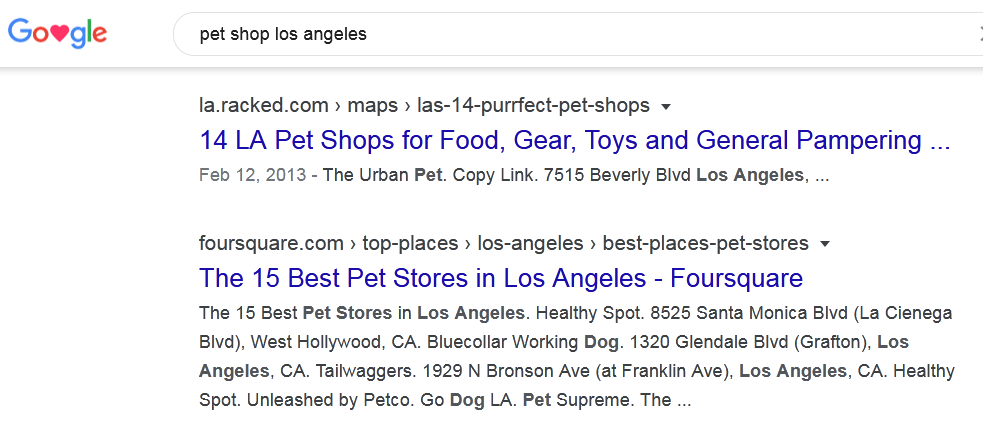6 Ways to Make Local SEO Easier for Your Clients

While standard SEO can improve your clients’ Google rankings, you need local SEO to boost sales and traffic to their local stores. Even if your clients don’t have a website (though that’s a must-have for modern businesses), local SEO can help them reach out to potential customers who are looking for businesses in close proximity.
Local SEO means optimizing your content so that it shows up in the top results when a person types a local query such as “carpenters near me” or “carpenters in Manhattan.”
If your client’s business has a number of stores in different destinations, local SEO can help drive customers to each store.
Why Your Client Needs Local SEO
Local SEO helps brands raise their rankings on the SERPs. When it comes to online searches, Google holds a market share of 87.35%.
That makes it an important source of traffic for brands with an online presence.
If your client’s site is among the top SERP results, their chances of getting discovered by searchers are strong.
But what about local SEO?
If we talk about local or “near me” searches, Google is used by one-third of Americans daily. And 16% of them do a local search on Google multiple times a week.
If you ace your local SEO, your client’s business can show up in relevant local search results on Google.
Local SEO can also have a direct correlation to sales.
Many local search queries have underlying purchase intent. Many consumers either call or visit the local stores that show up in their Google search. That means a strong local SEO authority improves your client’s chances of making a sale.
To give your clients a competitive edge over other local businesses in the same domain, you can leverage the tips below.
1. Get Them Listed in Local Directories
A lot of traffic for local businesses comes from directories and, therefore, it’s important to get listed in them. Google My Business (GMB) and Bing Places for Business should be your starting points if you want greater visibility for your clients.
Why Your Client Needs This Strategy
GMB can be a great source of traffic for your client’s local business. 64% of people use GMB to find the contact details of a local business. If the GMB listing is accurate and up-to-date, your client can expect a spike in in-store or online traffic.
Image via BrightLocal
If your client has a strong GMB listing, their business can show up in relevant direct search or discovery search results.
While traditional business directories are still popular, online sources have an unmatched edge. The Local Consumer Review Survey says that 90% of consumers searched for local businesses using the Internet in 2018-19.
An impressive listing on domain-specific directories like Yelp, TripAdvisor, and others can inspire confidence from customers and enrich your clients’ business portfolio.
How to Nail This Strategy
Posting great listings on GMB and Bing for Places should be your priority. Additionally, you can submit your clients’ NAP (name, address, and phone number) to national directories like the Yellow Pages, Manta, and Hotfrog.
The top three business listings that appear on the SERPs when a user types a local intent query are commonly called “local pack” and these are the most clicked pages. Your aim should be to secure a place in this esteemed group for your clients.
You can set up a GMB account for your clients for free. Ideally, the listing should contain complete, accurate, and fresh information at all times.
Apart from essentials like business name, phone number, and address, you should include website address, business hours, customer reviews, and business category. You must select the business category wisely and write an impactful business description.
Image via Google
Some businesses like hotels and restaurants have the option of including finer details such as full menus and room categories. You should answer customer queries promptly and encourage customers to rate and review your clients’ products and services. The more comprehensive your clients’ listing is, the more credible their business will look.
2. Optimize Their Website for Mobile
Making your client’s website mobile-friendly can help their business in more ways than one. By designing their website for mobile users, your client will demonstrate a strategic understanding of their customers and an intent to meet them where they are active.
Why Your Client Needs This Strategy
Local and mobile searches go hand-in-hand. Many local searches happen via mobile devices. 92% of customers look up a local business website after locating it in a Google search.
For instance, if you are traveling to a new city, you might want to check out restaurants around you for a quick snack.
Needless to say, if your client’s website doesn’t provide a good mobile experience, they will lose out on loads of traffic.
Mobility is so important to brands now that some brands peg mobile as the “first screen.” They design sites for mobile first, and desktop later.
How to Nail This Strategy
Double-check the following aspects in order to get responsive websites that are perfectly designed for local SEO:
- Schema markup must be added to all your clients’ pages. It tells search engines the context of a page and helps them look up the right page quickly.
- Page load time is a critical factor in building mobile-friendly sites. Images and rich media items should be compressed to load faster. You can switch to a more robust CMS or web-hosting platform.
- Intuitive site architecture improves the site’s usability and encourages visitors to stay on-page longer. Google considers ‘time on page’ as an important factor for site ranking.
- Enable social sharing by adding social sharing buttons on all pages.
- Ensure there are no broken links to reduce page bounce rates. Sufficient internal links and authority backlinks also play a crucial role in Google’s ranking algorithm.
You might be tempted to build a separate website for mobile devices instead of overhauling your clients’ existing website, but that’s not a good idea.
Google penalizes duplicate content heavily so it makes sense to tweak your clients’ local websites to make them mobile-optimized. Google’s Mobile-Friendly Test conducts rigorous checks on websites and detects gaps and anomalies.
Image via Google
3. Create a List of Local Industry Websites for Guest Posting
Guest posting is just as important for local businesses as it is for any other company. However, it is more effective if you post content on websites that have a similar target audience. Building a list helps make things easier in the long run.
Why Your Client Needs This Strategy
Guest posting on local industry websites not only increases credibility but also earns valuable backlinks and citations. As stated earlier, both of these factors are regarded highly by Google and can help your client climb up the SERPs.
Local businesses have a small target audience to impress and engage. They can become a “small-town authority” by posting great content on authority websites in their area.
Locals are likely to prefer a neighborhood business rather than a multinational brand for their smaller purchases.
If your client is one of the top-ranked local businesses in their domain, they have a strong shot at earning new customers.
Image via Google
How to Nail This Strategy
If you’re already guest posting, it makes sense to perform a backlink analysis. The audit will reveal insights such as the profiles of sites linking to you and to your competitors. You will get a fair idea of where you stand in search results and how you can elevate your rankings.
One thing you need to understand when compiling your client’s target site lists is that you should give preference to local businesses working in the same domain. For instance, if your client owns an electronic fittings store, it will serve them well to guest post on sites that deal with home appliances or electronic/industrial goods.
Once you identify relevant local business sites, you need to create quality posts that align with the quality standards and specifications of the target sites. Try including internal links to their pages and one or two to your client’s pages.
Then, you can connect to their team via social media or email, and pitch a guest posting proposal. The outreach email should have a compelling email subject line that the receiver just can’t ignore.
In the outreach email, highlight the local connection and elaborate on how a guest post will be mutually beneficial. Try to work out a comfortable posting schedule and keep posting consistently to cultivate a fan base.
4. Create a Database of Local Keywords
An important rule of local SEO is to use local keywords, preferably long-tail ones like a user would actually type in a search query.
Building a database of such keywords helps organize the process and saves time when you create new content.
Why Your Client Needs This Strategy
It’s true that local searches have lower search volume, but they are likely to have a higher purchase intent. The more keyword-rich your client’s page title and meta description, the higher their local website is likely to rank on the SERPs.
But mindlessly stuffing your page tags with keywords is not advisable.
Google’s crawlers show no mercy to people who try to outsmart its algorithms. Your page can get flagged or reported. It’s best to keep your title and description contextually-relevant as well as optimized.
How to Nail This Strategy
You should do a keyword search for every region separately. Your clients’ on-page SEO should be based on the exact search terms you get after using keyword tools. Keyword-focused pages will get more traffic and convert faster than pages based on vague translations of general keywords.
The page title and meta description should contain focus key terms in the local language. If you have multiple pages with duplicate content (for instance, the U.S. and U.K. sites with similar content), you should use canonical tags in the page code. These are HTML elements that help search engines index and rank the “preferred” page whenever they encounter duplicate content.
Image via Google
Keyword search tools will give you a list of high volume/low difficulty keywords, but using keywords strategically in page code is tricky.
5. Use the Right Tools
Using the right tools can reduce the time and effort that goes into optimizing a local site’s performance. It can also help you become more efficient.
Why Your Client Needs This Strategy
Local SEO tools can ensure that your client’s SEO is fail-proof.
These tools can eliminate errors caused by human negligence. They perform audits that pinpoint loopholes in local SEO and also provide intelligent suggestions to plug the gaps.
It’s also important that your client keeps their website updated. You may not always have the time to invest in their site’s upkeep.
In such a scenario, website designing tools can come in handy. They auto-update websites and optimize them for load time and performance. Using their built-in metrics, you can understand if your local SEO strategies are working or not.
Social media listening tools can help you track brand mentions. Whenever you see a mention, you can jump in on the conversation and answer customer queries easily. It’s a great way to boost engagement.
How to Nail This Strategy
BrightLocal’s local SEO tools vet pages for major local SEO ranking factors and track their rankings on local SERPs. They also evaluate each page’s citations and backlinks and compare them to benchmarks. Integrations with GMB and Google Analytics let you access SEO insights from within the tool interface.
Website builders like Wix and Constant Contact have drag-and-drop editors using which you can tweak your site in minutes.
For tracking mentions of your clients’ local businesses, you can also leverage social listening tools like Talkwalker and Mention.
6. Add a Landing Page for Each of Their Store Locations
Separate landing pages for different locations will attract organic local search traffic. If your client owns stores in multiple locations, you need to create dedicated pages (content hubs) for each location.
Why Your Client Needs This Strategy
Dedicated landing pages for each store location can act as signposts for crawlers.
If you use the right keywords, these pages will attract search engines and help your pages rank higher.
Once crawlers direct relevant audiences to your local pages, your localized pages can retain audiences for longer since they contain content with a local flavor.
Your site’s dwell time is likely to improve which will, in turn, boost its ranking. Also, more engaged visitors are more likely to convert. So, your sales conversions are bound to soar.
How to Nail This Strategy
It can be a pain to create separate landing pages for each location. Landing page builder tools can help you create landing pages that are optimized, non-generic, and visually stunning.
You should also activate the geolocation targeting functionality in Google Webmaster tools if your client uses subdomains for local sites.
It’s also a good idea to “localize” your clients’ pages. Try to include the store’s location throughout the website content as naturally as possible and take care of the content’s readability too. Use the local language and feature articles about local community events and personalities. In this way, your clients’ webpages won’t be flagged for looking promotional or keyword-stuffed.
Image via Google
Your clients can also involve themselves in community activities (not necessarily online). Their volunteer or charity efforts can earn them valuable tags and unstructured citations from press coverage at the events.
They can also create authentic content with a local flavor for the local website. The biggest win is that they come across as genuine not only to search engines but also to the local community.
Conclusion
Local SEO is the lifeblood for businesses with multiple locations. It improves the visibility of local businesses and boosts traffic to their website and stores. But the goals and best practices of local SEO are far removed from standard SEO.
That’s where a specialist agency can help. BrightLocal has been in the local SEO business for decades and deals with businesses of all scopes and sizes. They deploy cutting-edge tools and white-label reporting to deliver maximum value to clients. Leave a comment if you need help with your client’s local SEO.
Sign Up For Our Mailing List
If you’d like to receive more in-depth articles, videos and Infographics in your inbox, please sign up below

Sign up for the newest articles from Curatti, delivered straight to your inbox
Featured image: Copyright: ‘https://www.123rf.com/profile_alphaspirit‘ / 123RF Stock Photo
Shane Barker
Latest posts by Shane Barker (see all)
- How to Use Hashtag Tracking to Optimize Your Social Media Content - January 14, 2021
- How to Engage Your Target Audience Using These 5 Tactics - October 21, 2020
- 5 Things to Keep in Mind for Your Next Digital Marketing Campaign - September 16, 2020







